Crocus care tips for August
Self-seeding flowers can be a blessing or a curse depending on your point of view. Many gardens are filled with free plants at this time of the year, but they are only an asset if you want to propagate lots of new ones. At all other times self-seeders need to be managed to prevent them becoming a weed problem. This means cutting back or deadheading directly after flowering, before they have a chance to scatter their seeds. If this is not practical, grow self-seeders where they can express their natural exuberance – after all, there’s nothing quite like the sight of swathes of self-sown bluebells in a woodland planting. If your garden doesn't quite match up to this, don’t despair. There are many other useful ways you can accommodate self-seeders effectively, including between cracks in the paving, alongside hedges, over banks and providing a carpet of colour between permanent trees and shrubs. But beware! Some invasive self-seeders, such as trifolium, solidago and Lysimachia punctata, are real garden thugs that spread like wildfire, drain the soil of nutrients and smother all in their path.
True or false?
Although some self-seeding plants produce offspring that are exact replicas of themselves, many others do not. This can be due to the fact the parent is a hybrid or is rather promiscuous - happily mixing its genetic stock with neighbouring closely related plants. This results in a feast of seedlings that can vary in size, vigour, habit and flower colour. This is where gardening gets really exciting because there’s no knowing what you might discover.
Best of the crop
There are some top self-seeders that are worth getting down on your hands and knees for - the rating is based on garden value and saleability at charity plant stalls:
Alchemilla mollis (8/10)
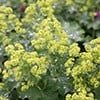 Lady’s mantle is top of the list for growing plants for school fund-raising events and charity stands. Not only does it come true from seed, so the offspring are exactly the same as the parent, but it’s popular and sells like hot cakes – especially if you have a flowering specimen plant in a pot alongside your seedlings to show what it looks like when fully grown. It is good for edging both sunny and shady borders and filling cracks in paving.
Lady’s mantle is top of the list for growing plants for school fund-raising events and charity stands. Not only does it come true from seed, so the offspring are exactly the same as the parent, but it’s popular and sells like hot cakes – especially if you have a flowering specimen plant in a pot alongside your seedlings to show what it looks like when fully grown. It is good for edging both sunny and shady borders and filling cracks in paving.
Allium christophii (9/10)
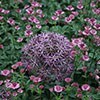 Many people are unaware that ornamental bulbs are self-seeders, so this beauty often goes unnoticed with its annual crop of seedlings removed unceremoniously while weeding in spring. Although less prolific that other alliums (such as wild garlic!), this one is a favourite because it comes true and its huge flowers are more open with a metallic contemporary look about them. If you want to sell them, have a picture of the flower to hand because the seedlings look pretty weedy. It will take 3-4 years to get flowering plants. Try growing it in a sunny border alongside ornamental grasses and lamb’s ears (Stachys byzantina).
Many people are unaware that ornamental bulbs are self-seeders, so this beauty often goes unnoticed with its annual crop of seedlings removed unceremoniously while weeding in spring. Although less prolific that other alliums (such as wild garlic!), this one is a favourite because it comes true and its huge flowers are more open with a metallic contemporary look about them. If you want to sell them, have a picture of the flower to hand because the seedlings look pretty weedy. It will take 3-4 years to get flowering plants. Try growing it in a sunny border alongside ornamental grasses and lamb’s ears (Stachys byzantina).
Aquilegia ‘Nora Barlow’ (7/10)
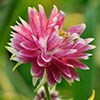 Columbines self-seed readily and are very easy to grow in sun or partial shade but, this is one of the few varieties which comes true from seed. Flowering in June, it’s an ideal candidate for those early summer fetes and fund-raising events. The unusual blooms, which have lime-green tipped petals, make excellent cut flowers. Grow them in full sun or partial shade alongside ornamental grasses and low-growing perennials.
Columbines self-seed readily and are very easy to grow in sun or partial shade but, this is one of the few varieties which comes true from seed. Flowering in June, it’s an ideal candidate for those early summer fetes and fund-raising events. The unusual blooms, which have lime-green tipped petals, make excellent cut flowers. Grow them in full sun or partial shade alongside ornamental grasses and low-growing perennials.
Campanula (6/10)
 The milky bellflower (C. lactiflora) is very prolific in partial shade where it will produce its large trusses of deep lilac or slate-blue bell-shaped flowers all summer long. Although it self-seeds freely, the seedlings do not come true to type so you will have to grow them on and be selective as they come into flower. The exception is the Dalmation bellflower (C. portenschlagiana) which does come true from seed. Mind you, both can be thugs in a small garden if not kept in check. Campanulas are good sellers at early summer charity events and make good border companions for late-flowering anemones and the airy flowers of gaura.
The milky bellflower (C. lactiflora) is very prolific in partial shade where it will produce its large trusses of deep lilac or slate-blue bell-shaped flowers all summer long. Although it self-seeds freely, the seedlings do not come true to type so you will have to grow them on and be selective as they come into flower. The exception is the Dalmation bellflower (C. portenschlagiana) which does come true from seed. Mind you, both can be thugs in a small garden if not kept in check. Campanulas are good sellers at early summer charity events and make good border companions for late-flowering anemones and the airy flowers of gaura.
Cyclamen (8/10)
 Hardy cyclamen have a reputation for being difficult to grow from seed, so one option is to let nature take its course and reap the harvest of self-sown seedlings. Both Cyclamen coum and C. hederifolium self-seed themselves about and spread naturally through a chipped bark mulch to create wonderful swathes of winter colour in dappled shade. Pot up seedlings as soon as they are large enough to handle safely, taking care not to damage the roots. Over-winter in a coldframe or cold greenhouse. Plants can take 2-3 years before they flower.
Hardy cyclamen have a reputation for being difficult to grow from seed, so one option is to let nature take its course and reap the harvest of self-sown seedlings. Both Cyclamen coum and C. hederifolium self-seed themselves about and spread naturally through a chipped bark mulch to create wonderful swathes of winter colour in dappled shade. Pot up seedlings as soon as they are large enough to handle safely, taking care not to damage the roots. Over-winter in a coldframe or cold greenhouse. Plants can take 2-3 years before they flower.
Digitalis (9/10)
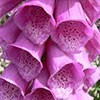 Foxgloves are short-lived plants that self-seed prodigiously. Not all come true, but most seedlings are worth keeping. Often you can start with swathes of white foxgloves that mysteriously turn into various shades of purple as the years go by. One old gardener’s trick to keeping your display pure is to weed out any seedlings with purple-streaked leafstalks which are often the ones that produce the purple flowers. If you can’t be bothered with the extra weeding, one foxglove that does seem to come true from seed is Digitalis x mertonensis. On the charity stall foxgloves are a hit and are my first choice for spring fairs and fetes.
Foxgloves are short-lived plants that self-seed prodigiously. Not all come true, but most seedlings are worth keeping. Often you can start with swathes of white foxgloves that mysteriously turn into various shades of purple as the years go by. One old gardener’s trick to keeping your display pure is to weed out any seedlings with purple-streaked leafstalks which are often the ones that produce the purple flowers. If you can’t be bothered with the extra weeding, one foxglove that does seem to come true from seed is Digitalis x mertonensis. On the charity stall foxgloves are a hit and are my first choice for spring fairs and fetes.
Erigeron karvinskianus (6/10)
 A real charmer with daisy-like flowers that’s ideal for a sunny, coastal or cottage-style gardens. It self-seeds freely and looks great springing up unexpectedly in mortar cracks between paving stones. Needs to be in flower to sell well, so an ideal candidate for late-summer fetes and fairs. Early in the season point out their potential as edging plants for windowboxes, hanging basket and patio container plants. Don’t introduce this plant to your garden if you are tidy minded!
A real charmer with daisy-like flowers that’s ideal for a sunny, coastal or cottage-style gardens. It self-seeds freely and looks great springing up unexpectedly in mortar cracks between paving stones. Needs to be in flower to sell well, so an ideal candidate for late-summer fetes and fairs. Early in the season point out their potential as edging plants for windowboxes, hanging basket and patio container plants. Don’t introduce this plant to your garden if you are tidy minded!
Eryngium giganteum (7/10)
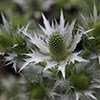 Miss Wilmott's ghost, as it’s commonly called, was named after the 19th-century gardener, Ellen Wilmott, who liked to secretly scatter these seeds in other people's gardens, so they would appear like magic the following season. Once established, it self-seeds freely and looks particularly good in prairie and gravel gardens. If you plan to sell the seedlings for charity, take a few dried stems from the parent along to the fair to illustrate the magnificence of this plant. Pot up seedlings as soon as they are large enough to handle safely and overwinter in a coldframe or cold greenhouse. Plants can take 2-3 years before they flower.
Miss Wilmott's ghost, as it’s commonly called, was named after the 19th-century gardener, Ellen Wilmott, who liked to secretly scatter these seeds in other people's gardens, so they would appear like magic the following season. Once established, it self-seeds freely and looks particularly good in prairie and gravel gardens. If you plan to sell the seedlings for charity, take a few dried stems from the parent along to the fair to illustrate the magnificence of this plant. Pot up seedlings as soon as they are large enough to handle safely and overwinter in a coldframe or cold greenhouse. Plants can take 2-3 years before they flower.
Geranium (8/10)
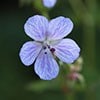 Many hardy geraniums self-seed generously, scattering their seeds using explosive seedheads. Two species that are a cut above the rest are Geranium endressii and G. pratense - both seem to come true to type from self-sown seed. Hardy geraniums also make good sellers on the plant stalls, especially once in flower: Geranium endressii between May and August and Geranium pratense from July to September.
Many hardy geraniums self-seed generously, scattering their seeds using explosive seedheads. Two species that are a cut above the rest are Geranium endressii and G. pratense - both seem to come true to type from self-sown seed. Hardy geraniums also make good sellers on the plant stalls, especially once in flower: Geranium endressii between May and August and Geranium pratense from July to September.
Helleborus orientalis (7/10)
 Lenten roses cross-pollinate and self-seed as though it was going out of fashion and are as variable as the British climate. Best of all, every plant is a surprise when it comes into bloom. Once you’ve started breeding your own hellebores, you’ll be hooked for life - with every shade of flower from white, through cream and pink to purple, as possible outcomes. The spotting and freckling is even more diverse and appealing. Plants can take 3-4 years or come into flower and they make very saleable charity stall plants, especially in spring and autumn.
Lenten roses cross-pollinate and self-seed as though it was going out of fashion and are as variable as the British climate. Best of all, every plant is a surprise when it comes into bloom. Once you’ve started breeding your own hellebores, you’ll be hooked for life - with every shade of flower from white, through cream and pink to purple, as possible outcomes. The spotting and freckling is even more diverse and appealing. Plants can take 3-4 years or come into flower and they make very saleable charity stall plants, especially in spring and autumn.
Hesperis matronalis (5/10)
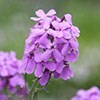 Although short-lived, sweet rocket. is a weed in some parts of the country, because it self-seeds all over the place. It will grow anywhere too, from beds and borders to cracks in walls and between paving. It doesn't reliably come true from seed, but with only white and mauve flowers as options, you can’t go far wrong. Currently, sweet rocket is back in fashion, so makes a good charity stall plant, especially during late spring just before it starts to come into flower.
Although short-lived, sweet rocket. is a weed in some parts of the country, because it self-seeds all over the place. It will grow anywhere too, from beds and borders to cracks in walls and between paving. It doesn't reliably come true from seed, but with only white and mauve flowers as options, you can’t go far wrong. Currently, sweet rocket is back in fashion, so makes a good charity stall plant, especially during late spring just before it starts to come into flower.
Lunaria annua (6/10)
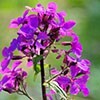 Honesty self-seeds freely in dappled shade from its distinctive flat, shimmering, silvery-white seedpods that also make great dried stems for indoor arrangements. They sell well at charity plant stalls if you make a point of their sweetly scented purple spring flowers as well as their eye-catching decorative seedpods. Ideal for wild areas and excellent companions for other woodland-edge plants.
Honesty self-seeds freely in dappled shade from its distinctive flat, shimmering, silvery-white seedpods that also make great dried stems for indoor arrangements. They sell well at charity plant stalls if you make a point of their sweetly scented purple spring flowers as well as their eye-catching decorative seedpods. Ideal for wild areas and excellent companions for other woodland-edge plants.
Meconopsis cambrica (7/10)
 Welsh poppies in shades of yellow and orange do come true from self-sown seedlings. Bear in mind that it is only those with single flowers that set seed. They are a bit invasive if given perfect growing conditions, so weed out unwanted seedlings early because the tenacious roots are difficult to eradicate once established. All poppies sell well on charity plant stalls.
Welsh poppies in shades of yellow and orange do come true from self-sown seedlings. Bear in mind that it is only those with single flowers that set seed. They are a bit invasive if given perfect growing conditions, so weed out unwanted seedlings early because the tenacious roots are difficult to eradicate once established. All poppies sell well on charity plant stalls.
Oenothera biennis (6/10)
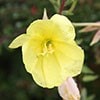 Another woodland-edge flower that self-seeds freely and spreads alarmingly if given ideal growing conditions. But the clear pale yellow flowers of the evening primrose make it worth the effort of keeping it in check. A good seller on charity plant stalls in spring, just before it flowers.
Another woodland-edge flower that self-seeds freely and spreads alarmingly if given ideal growing conditions. But the clear pale yellow flowers of the evening primrose make it worth the effort of keeping it in check. A good seller on charity plant stalls in spring, just before it flowers.
Papaver (9/10)
 Annual poppies are prolific self-seeders, but who cares because you can’t have too many! Grow them in full sun as part of a wildflower meadow or prairie planting, where they will add seasonal highlights. Results can be variable, but they’ll all look like poppies and the opium poppy (Papaver somniferum) has particularly attractive seedheads too. All annual poppies sell well as seedlings, especially if you have a picture of the flower in its full glory as a reminder of what’s to come.
Annual poppies are prolific self-seeders, but who cares because you can’t have too many! Grow them in full sun as part of a wildflower meadow or prairie planting, where they will add seasonal highlights. Results can be variable, but they’ll all look like poppies and the opium poppy (Papaver somniferum) has particularly attractive seedheads too. All annual poppies sell well as seedlings, especially if you have a picture of the flower in its full glory as a reminder of what’s to come.
Sisyrinchium (6/10)
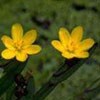 These summer-flowering perennials are perfect for a sunny herbaceous or mixed border. They make good companions for grey- and silver-leaved foliage plants, and perform best in well-drained, neutral to slightly alkaline soil. Sisyrinchium striatum and S. californicum Brachypus Group both spread themselves about and come true from self-sown seedlings. What’s more the seedlings are easy to handle, so losses when potting up are few.
These summer-flowering perennials are perfect for a sunny herbaceous or mixed border. They make good companions for grey- and silver-leaved foliage plants, and perform best in well-drained, neutral to slightly alkaline soil. Sisyrinchium striatum and S. californicum Brachypus Group both spread themselves about and come true from self-sown seedlings. What’s more the seedlings are easy to handle, so losses when potting up are few.
Happy gardening!



















